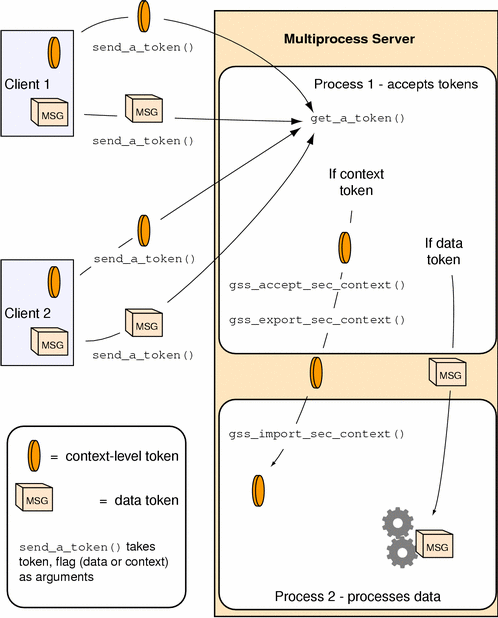Context Export and Import
The GSS-API provides a means for exporting and importing a context. The primary reason for this ability is to allow a multiprocess application (usually the context acceptor) to transfer a context from one process to another. For example, an acceptor might have one process that listens for context initiators and another that processes data sent in a context. (test_import_export_context() shows how a context can be saved and restored with these functions.)
The function gss_export_sec_context() creates an interprocess token that contains information about the exported context. (See Interprocess Tokens. This buffer to receive the token should be set to GSS_C_NO_BUFFER before gss_export_sec_context() is called.)
The application then passes the token on to the other process, which accepts it and passes it to gss_import_sec_context(). The same functions used to pass tokens between applications can often be used to pass them between processes as well.
Only one instantiation of a security process can exist at a time. gss_export_sec_context() deactivates the exported context and sets its context handle to GSS_C_NO_CONTEXT. It also deallocates any and all process-wide resources associated with that context. In the event that context exportation cannot be completed, gss_export_sec_context() does not return an interprocess token, but leaves the existing security context unchanged.
Not all mechanisms permit contexts to be exported. An application can determine whether a context can be exported by checking the ret_flags argument to gss_accept_sec_context() or gss_init_sec_context(). If this flag is set to GSS_C_TRANS_FLAG, then the context can be exported. (See Context Acceptance (Server) and Context Initiation (Client).)
Figure 1–10 shows how a multiprocess acceptor might use context exporting to multitask. In this case, Process 1 receives and processes tokens, separating the context-level tokens from the data tokens, and passes the tokens on to Process 2, which deals with data in an application-specific way. In this illustration, the clients have already gotten export tokens from gss_init_sec_context(); they pass them to a user-defined function, send_a_token(), which indicates whether the token it's transmitting is a context-level token or a message token. send_a_token() transmits the tokens to the server. Although not shown here, send_a_token() would presumably be used to pass tokens between threads as well.
Figure 1–10 Exporting Contexts: Multithreaded Acceptor Example

- © 2010, Oracle Corporation and/or its affiliates
